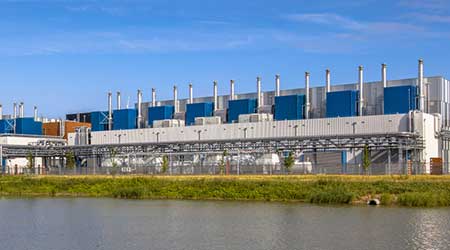Keeping Data Center Construction on Schedule
Good communication is one key to preventing delays.
The market for building new data centers right now is “white hot,” says Gary Cudmore, global director, data centers, Black & Veatch. “Billions and billions of dollars are being spent on new data center construction all over the world,” he says. And since time is money, many data center owners are taking steps to reduce time to market.
For example, the big five — Amazon, Apple, Facebook, Google, and Microsoft — use repeatable design that has already been vetted to increase velocity. Nonetheless, a template still has to be adapted to local conditions on a specific piece of ground, and time could be lost on permits and approvals for land mitigation, for example. Supply chain issues can also negatively affect a project’s schedule. “It’s important to understand all permits and regulations before you start,” Cudmore says, “and make sure the supply chain for major pieces of equipment is in order and will meet the delivery dates for critical path construction.”
To accelerate data center construction projects, and to avoid scheduling delays, cloud providers and co-location companies are using “a lot of modular construction prefabricated off site,” says Cudmore Not only does modular construction help control costs and speed up construction, it also enables companies to build the data center out on an as-needed basis.
Terence Deneny, vice president, Structure Tone Mission Critical, also notes that “colocation companies are building at a record pace and investing record amounts of money to build data centers, and many large equipment manufacturers are extending lead times to historic highs.” Thus, to maintain an accurate budget and schedule, facility managers must take into consideration how procurement of various pieces of electrical and mechanical equipment can push out a timeline.
Scheduling headaches can occur when a building owner hires a contractor who doesn’t understand the market. “You can lose scheduling very quickly and have budget overruns,” says Tim Janof, principal, electrical engineering, Stantec. For example, the contractor needs to know that generators require 24 to 36 weeks of lead time and must be preordered well before the project commences. If equipment is not ordered ahead of time, the project can fall behind on Day 1, he said.
Another problem is “a lack of coordination or miscoordination between trades,” says Jason Smith, principal, mechanical engineering, Stantec. For example, engineers create redundant backup systems to correct for possible equipment failures. But if the mechanical and electrical engineers are using different design typologies and have not been talking to each other, their designs will need to be reconciled after the fact, which will result in scheduling delays.
Accurate scheduling also depends on team involvement from the project’s inception, including from the building owner’s side, Deneny says. For example, various consultants — such as acoustical, environmental, IT, audiovisual, or security consultants — should be brought in very early so that their requirements can baked into the project and accounted for on the schedule. In addition, there are five levels of commissioning for a data center involving the testing of equipment and other physical aspects of the facility. These requirements add time to the schedule and must be delineated and understood from the beginning if the project train is to be kept on schedule.
An important factor that can have a negative impact on scheduling is a lack of skilled labor in less populated parts of the country. “The amount of manpower you need also increases as data centers get larger,” Deneny says. “Hundreds and hundreds of trades people [are needed for each project], and finding them in remote locations is becoming more difficult.” When skilled laborers — such as electricians, carpenters, or HVAC technicians — cannot be found to do the necessary work, the schedule is pushed out. Deneny says trade organizations are doing more active recruitment of young people in response to labor shortages. These jobs pay as well as or better than many white-collar entry-level jobs or even professional jobs held by college graduates three to five years after graduation, Deneny notes.
In the absence of skilled labor, contractors can use “prefab critical components” and have “large sections of pipe delivered to the site,” says Deneny, a system that has distinctive advantages. “In factory-like settings the quality control is better.” MEP (mechanical, electrical, and plumbing) is “65 to 70 percent of the budget of any data center job and has the biggest impact in terms of budget, schedule, and constructability,” Deneny says. By using parts built in factories and shipped to data center sites, facility managers can maintain or even get ahead of their schedules.
Adhering to a schedule may be more difficult for renovations, in which unknown factors crop up once the work is underway. The schedule is likely to be extended, says Stephen Webb, senior associate at Dewberry, when a data center is transitioning from older to newer systems. The process can take longer than anticipated when project managers find it necessary to reevaluate risk. It is not uncommon to find mistakes and irregularities when a data center is being renovated, and in such cases it is better to revamp the schedule rather than risk a shutdown.
Another reason schedules may be pushed out is scope creep during renovations. “We start out with one concept, such as modernizing the cooling system, but then the client may ask for more money for new UPS,” Webb says. Such scope creep may occur in a university or health care setting, in which funding is supplied by an institutional or governmental source. Pushing out the schedule is not necessarily a problem in these scenarios, if everyone agrees that the money and time would be well spent.
Maryellen Lo Bosco is a freelance writer who covers facility management and technology. She is a contributing editor for Building Operating Management.
Related Topics:











